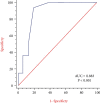Establishment and Verification of Logistic Regression Model for Qualitative Diagnosis of Ovarian Cancer Based on MRI and Ultrasound Signs
- PMID: 35211186
- PMCID: PMC8863462
- DOI: 10.1155/2022/7531371
Establishment and Verification of Logistic Regression Model for Qualitative Diagnosis of Ovarian Cancer Based on MRI and Ultrasound Signs
Retraction in
-
Retracted: Establishment and Verification of Logistic Regression Model for Qualitative Diagnosis of Ovarian Cancer Based on MRI and Ultrasound Signs.Comput Math Methods Med. 2023 Dec 6;2023:9831701. doi: 10.1155/2023/9831701. eCollection 2023. Comput Math Methods Med. 2023. PMID: 38094461 Free PMC article.
Abstract
Objective: To explore the establishment and verification of logistic regression model for qualitative diagnosis of ovarian cancer based on MRI and ultrasonic signs.
Method: 207 patients with ovarian tumors in our hospital from April 2018 to April 2021 were selected, of which 138 were used as the training group for model creation and 69 as the validation group for model evaluation. The differences of MRI and ultrasound signs in patients with ovarian cancer and benign ovarian tumor in the training group were analyzed. The risk factors were screened by multifactor unconditional logistic regression analysis, and the regression equation was established. The self-verification was carried out by subject working characteristics (ROC), and the external verification was carried out by K-fold cross verification.
Result: There was no significant difference in age, body mass index, menstruation, dysmenorrhea, times of pregnancy, cumulative menstrual years, and marital status between the two groups (P > 0.05). After logistic regression analysis, the diagnostic model of ovarian cancer was established: logit (P) = -1.153 + [MRI signs : morphology × 1.459 + boundary × 1.549 + reinforcement × 1.492 + tumor components × 1.553] + [ultrasonic signs : morphology × 1.594 + mainly real × 1.417 + separated form × 1.294 + large nipple × 1.271 + blood supply × 1.364]; self-verification: AUC of the model is 0.883, diagnostic sensitivity is 93.94%, and specificity is 80.95%; K-fold cross validation: the training accuracy was 0.904 ± 0.009 and the prediction accuracy was 0.881 ± 0.049.
Conclusion: Irregular shape, unclear boundary, obvious enhancement in MRI signs, cystic or solid tumor components and irregular shape, solid-dominated shape, thick septate shape, large nipple, and abundant blood supply in ultrasound signs are independent risk factors for ovarian cancer. After verification, the diagnostic model has good accuracy and stability, which provides basis for clinical decision-making.
Copyright © 2022 Xiao Guo and Guangcai Zhao.
Conflict of interest statement
The authors declare that they have no competing interests.
References
-
- Li B. X., Wang H. B., Qiu M. Z., et al. Novel smac mimetic APG-1387 elicits ovarian cancer cell killing through TNF-alpha, ripoptosome and autophagy mediated cell death pathway. Journal of Experimental & Clinical Cancer Research . 2018;37(1):p. 53. doi: 10.1186/s13046-018-0703-9. - DOI - PMC - PubMed
-
- Feng X. H., Yan S. J., Xiao L., Wei Z. L. The role of CCL23-CCR1 chemokine axis in the progression of epithelial ovarian cancer. Journal of Anhui Medical University . 2020;55(5):780–785.
-
- Yi S., Liyuan W. Expression and clinical significance of CXCR4 and MMP-9 in epithelial ovarian cancer. China Maternal and Child Health . 2019;34(4):926–929.
-
- Yang N., Han Y. Y., Zhang M. N., Zhang Y. T., Gong L. H., Qu Y. J. Computer-aided ultrasound diagnosis improves the accuracy of ovarian cancer diagnosis. Advances in Modern Biomedicine . 2017;17(2):276–279.
-
- OuyangJingwen T. R., Jia Z. Comparative analysis of CT and ultrasound imaging features of ovarian cancer and postoperative pathological examination results. Chinese Journal of CT and MRI . 2019;17(7):110–112.
Publication types
MeSH terms
LinkOut - more resources
Full Text Sources
Medical
Miscellaneous


